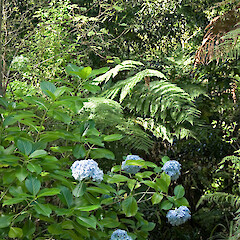Hydrangea macrophylla
Common name
hydrangea
Family
Hydrangeaceae
Flora category
Vascular – Exotic
Structural class
Trees & Shrubs - Dicotyledons
NVS code
The National Vegetation Survey (NVS) Databank is a physical archive and electronic databank containing records of over 94,000 vegetation survey plots - including data from over 19,000 permanent plots. NVS maintains a standard set of species code abbreviations that correspond to standard scientific plant names from the Ngä Tipu o Aotearoa - New Zealand Plants database.
HYDMAC
Conservation status
Not applicable
Habitat
Terrestrial. Persistent around old homesteads, near water and on forest margins.
Detailed description
Deciduous rounded shrub to about 2 m tall with suckering habit. Leaves tend to be towards the end of the branches and are ovate and up to about 20 x 15 cm, margins coarsely serrate. Flower head either rounded or flat. Usually composed of sterile flowers (especially in cultivation) but can have fertile flowers in centre. Seed capsule to about 5 mm long.
Similar taxa
Hydrangea is very familiar to New Zealand gardeners, wild material can appear quite different with flat inflorecences containing sterile flowers.
Flowering
November, December, January, February, March.
Flower colours
Blue, Violet/Purple
Life cycle
Reproduces by suckering, persisting from cultivation and seed. Viable seed can be produced. Dispersed by people and gravity.
Year naturalised
1975
Origin
Japan
Reason for introduction
Ornamental.
Tolerances
Prefers damp shady areas.
Etymology
hydrangea: From the Greek hydor ‘water’ and aggeion ‘a vessal or vase’, referring to the shape of the seed capsules.
macrophylla: Big leaf
References and further reading
Johnson, A. T. and Smith, H. A (1986). Plant Names Simplified: Their pronunciation, derivation and meaning. Landsman Bookshop Ltd: Buckenhill, UK.






